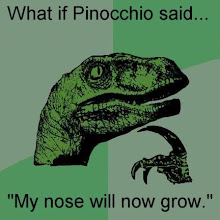Let the polar bears die, liberals: It's only your beloved evolution at workThe author sums up here feelings quite nicely a few paragraphs down:
But here's a question that's rarely asked: Why should we necessarily bother saving a species - any species - from extinction? And what's so gosh-darn special about the polar bear? Yes, animals are dying. But death - of a single animal or a whole species - is a part of life.These sentiments make sense until you dig deeper into the problem. Extinction is one of the most often overlooked parts of evolution but as recent papers have pointed out, and many people knew just based on common sense, is that we would not be here were it not for the extinction of the dinosaurs and mass extinctions give rise to new niches for species to fill (Smith et al., 2010). So extinctions in and of themselves are good and an important part of evolutionary theory. What is more is that there are always background levels of extinctions. So is the author of this piece right?
At least, that's what Darwinists tell us. In fact, if you think hard about it, animal conservation should actually be anathema to the Darwin-loving liberal agenda, which holds up evolution - and not altruistic compassion - as the final word on the survival of a species.
Sure, it's possible that we're crowding out the polar bear - but aren't we animals, too? And don't animals sometimes crowd each other out? Isn't it entirely possible that the polar bear is simply going extinct, like countless species before it?
Well the answer is no not really. Eventually given enough time every species that is alive today would be extinct, yes even those that closely resemble their ancient ancestors are considered different species. The main problem is the rate and how species are going extinct. A recent paper argued that it may have taken upwards of 10 million years for species diversity to recover from the end-Permian mass extinction (Hu et al., 2010). While the end-Permian was an extreme mass extinction the time frame from the K-T extinction may have been similar.
But why am I referencing mass extinctions and not just the loss of a single individual? Simple, this extinction will not just involve the loss of one single species. If climate change continues it will threaten total ecological collapse in the arctic and antarctic. This means that not only will the polar bear die off but most if not all species of flora and fauna in these areas will as well. But it is not just the poles that are threatened but the entire planet. Temperature changes will push many flora away from where they currently live, with the loss of the base of the food chain a total collapse will likely follow. While less likely to occur elsewhere it is a possibility.
Another way of looking at it is by what I am calling the Yellowstone Wolf effect. In general the idea is this: As top predators when the wolves were all killed in Yellowstone it allowed the primary source of food to reproduce almost unchecked, there are other animals that will feed on elk but tend to do so less often than wolves. This damaged the amount of plant life present and hurt animals that will then have to compete with the elk for food. When the wolves were reintroduced this put stress on the elk as their numbers declined many different flora where able to better survive it also increased the amount of food available for scavengers and other predators such as Bear and Coyote (Smith, 2005; White et al., 2005).
The concern for the polar bears is therefore not just for the bears themselves but for the entire ecosystem. We have hurt it in ways we are not completely sure of yet but if we have the power to prevent a total collapse, which we likely do in some areas, shouldn't we?
Sources
Hu, S.-x., Q.-y. Zhang, Z.-Q. Chen, C.-y. Zhou, T. Lü, T. Xie, W. Wen, J.-y. Huang, and M.J. Benton. (2010). The Luoping biota: exceptional preservation, and new evidence on the Triassic recovery from end-Permian mass extinction. Proc. R. Soc. B published online before print December 23, 2010, doi:10.1098/rspb.2010.2235
Smith, D.W. (2005). Ten Years of Yellowstone Wolves 1995–2005. Yellowstone Science. 13 (1), 34-41 (Freely available here)
Smith, F.A., A.G. Boyer, J.H. Brown, D.P. Costa, T. Dayan, S.K.M Ernest, A.R. Evans, M. Fortelius, J.L. Gittleman, M.J. Hamilton, L.E. Harding, K. Lintulaakso, S.K. Lyons, C. McCain, J.G. Okie, J.J. Saarinen, R.M. Sibly, P.R. Stephens, J. Theodor, and M.D. Uhen. (2010). The Evolution of Maximum Body Size of Terrestrial Mammals. Science; 330 (6008): 1216-1219 DOI: 10.1126/science.1194830
White, P.J., D.W. Smith, J.W. Duffield, M. Jimenez, T. McEneaney, G. Plumb. (2005) Yellowstone After Wolves: Environmental Impact Statement Predictions and Ten-Year Appraisals. Yellowstone Science. 13 (1), 34-41 (Freely available here)

No comments:
Post a Comment